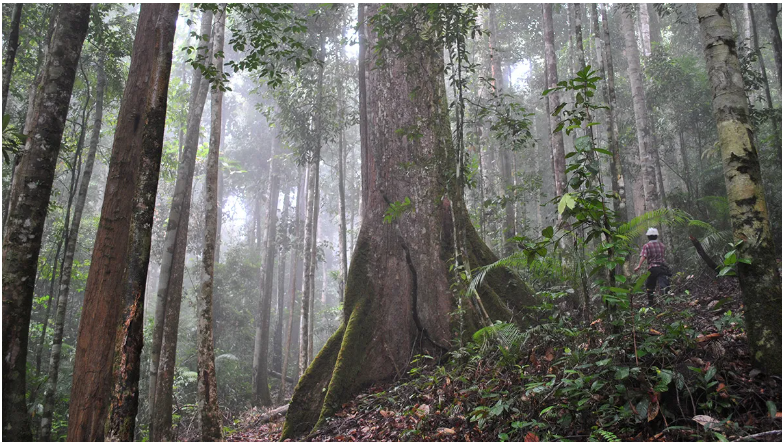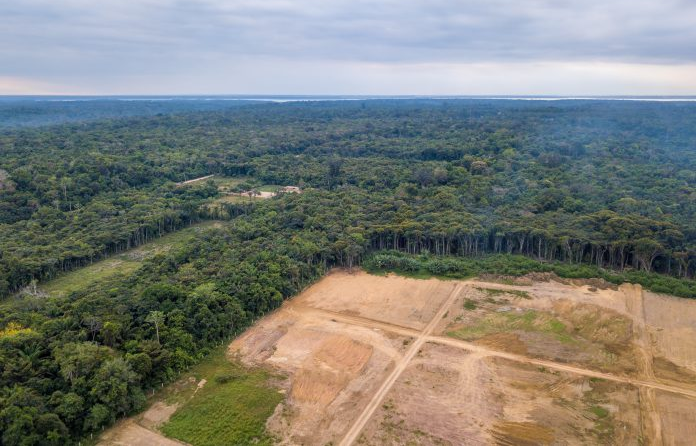More than a quarter of global forest loss is driven by commodity production, which includes logging wood. Though illegal deforestation supplies some of the timber in products such as furniture and window frames, independently verifying origins of the wood in finished products is a daunting task. Now, researchers are finding new ways to fingerprint timber.
The chemical composition of wood varies geographically. Scientists from Wageningen University & Research in the Netherlands analyzed the makeup of wood samples from nearly 1,000 different trees in Cameroon, Congo, and Gabon in Central Africa, as well as the Indonesian portion of the island of Borneo, and found that it’s possible to trace their origins to subnational scales. The researchers tout the analysis as a step toward a global timber-tracing tool.
“The most important motivation [to undertake the research] was to further improve small-scale tracing,” said data scientist Laura Boeschoten, “but in the end, mostly to reduce illegal timber trade.” Boeschoten is the lead author of the study and a Ph.D. candidate at Wageningen. Current methods of timber tracing do not consistently narrow a sample’s origin to areas smaller than 100 kilometers, the distance that would be needed to accurately identify wood illegally logged.
Tracing Elements to Trace Timber
The team sampled heartwood from three economically important tropical timbers: azobé and tali in Central Africa and red meranti in Borneo. They noted GPS coordinates of the trees, which were located within forest concessions—government-designated forest areas in which logging is administered by a private entity.
The researchers dissolved each sample and measured the amounts of roughly 40 elements, including magnesium, calcium, and lanthanum, to develop a fingerprint of each forest concession. They then developed an assignment model, which used machine learning to determine a sample’s most likely origin. The assignment model was trained on the basis of random subsets of the database, after which test samples were assigned to their most likely origin.
One limitation of the tool is that it helps answer the question of “Does this timber come from this particular region?” but not “Where does this wood come from?”
Because a tree’s chemical makeup varies by region, machine learning helps to distinguish the top elements present in a particular region. For instance, noted forest ecologist and study coauthor Pieter Zuidema from Wageningen University, the samples show that western Cameroon has a high concentration of molybdenum, whereas concentrations of natrium are higher in the eastern part of the Republic of Congo, and silicon concentrations are higher in northern Borneo.
The researchers found that samples could be traced back to their subnational origin with between 86% and 98% accuracy in Central Africa and to their forest of origin with 88% accuracy in Borneo. When samples were provided by an independent third party to create a real-world test, the model located their subnational origin with between 70% and 72% accuracy.
One limitation of the tool is that it helps answer the question of “Does this timber come from this particular region?” but not “Where does this wood come from?” Zuidema said. Future research would need to tweak the tool to make it more open-ended.
Meeting Legislation Goals
Such multielement analysis exists for other products, including asparagus, bananas, and tea. “But this is the first time it has been applied to wood,” said Zuidema. “I definitely see the high potential of this technique, and any new finding is a huge step forward in the right direction.”
The analysis could be an important tool in light of new antideforestation legislation in the European Union (EU), which requires companies to prove that the products they sell in the EU have not resulted in deforestation and forest degradation as per laws in the country of origin. The law regulates such products as beef, cocoa, coffee, palm oil, rubber, soy, and wood.
“I definitely see the high potential of this technique, and any new finding is a huge step forward in the right direction,” said Victor Deklerck, research leader of World Forest ID at the Royal Botanic Gardens, Kew, in the United Kingdom. But he also acknowledged that wood chemistry is not straightforward. “Trace element quantities can differ between years and tree rings, and more research is needed on how consistent the signal is,” he added.


